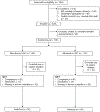Does Quantitative Sensory Testing Improve Prediction of Chronic Pain Trajectories? A Longitudinal Study of Youth With Functional Abdominal Pain Participating in a Randomized Controlled Trial of Cognitive Behavioral Treatment
- PMID: 34192714
- PMCID: PMC8373792
- DOI: 10.1097/AJP.0000000000000956
Does Quantitative Sensory Testing Improve Prediction of Chronic Pain Trajectories? A Longitudinal Study of Youth With Functional Abdominal Pain Participating in a Randomized Controlled Trial of Cognitive Behavioral Treatment
Abstract
Objectives: Youth with functional abdominal pain (FAP) experience significant pain-related distress and functional impairment. Although quantitative sensory testing protocols have identified alterations in pain modulatory systems that distinguish youth with FAP from healthy controls, the extent to which evoked pain responses predict subsequent trajectories of pain symptoms and disability over and above established psychosocial risk factors is unclear.
Methods: The present study included 183 adolescents with FAP who were enrolled in a randomized controlled trial comparing an 8-week, internet-delivered program of cognitive behavior therapy (n=90) or pain education (n=93). Participants completed a quantitative sensory testing protocol before the intervention and were followed for 12-month posttreatment.
Results: Whereas adolescents with FAP who exhibited stronger baseline conditioned pain modulation (CPM) reported decreases in pain-related interference over follow-up (b=-0.858, SE=0.396, P=0.032), those with weaker CPM exhibited high, relatively stable levels of pain-related interference over time (b=-0.642, SE=0.400, P=0.110). CPM status predicted changes in pain-related interference after controlling for the effects of treatment condition and psychosocial risk factors. Static measures of pain sensitivity (ie, pain threshold, pain tolerance) and temporal summation of second pain were not associated with changes in measures of abdominal pain, gastrointestinal symptom severity, or pain-related interference over follow-up.
Discussion: The present findings contribute to a growing literature on the predictive utility of quantitative sensory testing indices and suggest that CPM may complement existing psychosocial risk measures in determining individualized pain-related risk profiles.
Copyright © 2021 Wolters Kluwer Health, Inc. All rights reserved.
Conflict of interest statement
The authors declare no conflict of interest.
Figures
Similar articles
-
Place and Pain: Association Between Neighborhood SES and Quantitative Sensory Testing Responses in Youth With Functional Abdominal Pain.J Pediatr Psychol. 2022 Apr 8;47(4):446-455. doi: 10.1093/jpepsy/jsab113. J Pediatr Psychol. 2022. PMID: 34757421 Free PMC article.
-
Internet-delivered cognitive behavioral therapy for youth with functional abdominal pain: a randomized clinical trial testing differential efficacy by patient subgroup.Pain. 2021 Dec 1;162(12):2945-2955. doi: 10.1097/j.pain.0000000000002288. Pain. 2021. PMID: 34793406 Free PMC article. Clinical Trial.
-
Impaired conditioned pain modulation in youth with functional abdominal pain.Pain. 2016 Oct;157(10):2375-2381. doi: 10.1097/j.pain.0000000000000660. Pain. 2016. PMID: 27389918 Free PMC article.
-
Mind Over Gut: Psychosocial Management of Pediatric Functional Abdominal Pain.J Pediatr Health Care. 2016 Nov-Dec;30(6):535-545. doi: 10.1016/j.pedhc.2015.11.011. Epub 2016 Jan 7. J Pediatr Health Care. 2016. PMID: 26774953 Review.
-
Importance of addressing anxiety in youth with functional abdominal pain: suggested guidelines for physicians.J Pediatr Gastroenterol Nutr. 2013 May;56(5):469-74. doi: 10.1097/MPG.0b013e31828b3681. J Pediatr Gastroenterol Nutr. 2013. PMID: 23412539 Free PMC article. Review.
Cited by
-
Biobehavioral Predictors of Pain Intensity, Pain Interference, and Chronic Pain Episodes: A Prospective Cohort Study of African-American Adults.J Pain. 2024 Aug;25(8):104501. doi: 10.1016/j.jpain.2024.02.015. Epub 2024 Feb 16. J Pain. 2024. PMID: 38369220 Free PMC article.
-
Adolescent predictors of young adult pain and health outcomes: results from a 6-year prospective follow-up study.Pain. 2025 Jan 1;166(1):42-51. doi: 10.1097/j.pain.0000000000003308. Epub 2024 Jun 25. Pain. 2025. PMID: 38916525
-
Physical activity, sitting time, and thermal quantitative sensory testing responses in African Americans.Pain Rep. 2023 Dec 26;8(6):e1118. doi: 10.1097/PR9.0000000000001118. eCollection 2023 Dec. Pain Rep. 2023. PMID: 38152687 Free PMC article.
-
Multimodal hypersensitivity derived from quantitative sensory testing predicts pelvic pain outcome: an observational cohort study.Pain. 2023 Sep 1;164(9):2070-2083. doi: 10.1097/j.pain.0000000000002909. Epub 2023 Apr 27. Pain. 2023. PMID: 37226937 Free PMC article.
-
Auricular Allodynia is Associated With Worse Outcomes in Children With Functional Abdominal Pain Disorders Using Neurostimulation.Neuromodulation. 2025 Jul;28(5):840-846. doi: 10.1016/j.neurom.2025.02.011. Epub 2025 Apr 10. Neuromodulation. 2025. PMID: 40208134
References
-
- Gieteling MJ, Bierma-Zeinstra SM, Passchier J and Berger MY. Prognosis of chronic or recurrent abdominal pain in children. Journal of pediatric gastroenterology and nutrition 2008;47:316–326. - PubMed
Publication types
MeSH terms
Grants and funding
LinkOut - more resources
Full Text Sources
Medical
Miscellaneous



